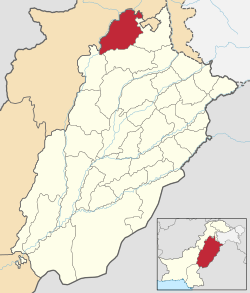Attock District
Attock District (ضِلع اٹک) is a district in Pothohar Plateau of the Punjab Province of Pakistan. Attock is the capital of the district.
Attock ضِلع اٹک | |
|---|---|
 Attock District highlighted within Punjab Province | |
| Coordinates: 33°45′57.6″N 72°21′39.2″E | |
| Country | Pakistan |
| Province | Punjab |
| Headquarter | Attock |
| Government | |
| • Chairperson District Council | Ms Eman Tahir[1] |
| Area | |
| • Total | 6,857 km2 (2,648 sq mi) |
| Elevation | 355 m (1,165 ft) |
| Population (2017)[2] | |
| • Total | 1,883,556 |
| • Density | 270/km2 (710/sq mi) |
| Time zone | UTC+5 (PKT) |
| Languages | Punjabi, Hindko, Urdu and Pashto |
| No. of Tehsils | 6 |
| Tehsils | Attock Fateh Jang Hazro Hassan Abdal Jand Pindi Gheb |
The district was created in April 1904[3] by the merging of tehsils of nearby districts. Its former name was Campbellpur. Today the district consists of 6 tehsils that are Attock, Fateh Jang, Hazro, Hassan Abdal, Jand and Pindi Gheb.
It is located in the north of the Punjab province, Attock district is bordered by Chakwal to its south, Mianwali to its south west, Rawalpindi to its east, Kohat to its west, Nowshera to its north west and Swabi and Haripur to its north.
History
The original name of Attock District was Attock. It was changed to Campbellpur after the Commander-in-Chief of British forces Sir Colin Campbell who rebuilt the city of Campbellpur. The name of the district was changed to Attock as of 1978 again.[4] Attock city is the district headquarters.
Demography
According to the 1998 census of Pakistan the district had a population of 1,274,935 of which 20.45% were urban.[5] The estimated population in 2008 was 1.58 million.
In the 1998 census, 87% of the population identified their language as Punjabi. Pashto was the language of 8.3% and Urdu – of 1.1%.[6] The Punjabi dialect of the eastern Fateh Jang Tehsil is called Sohāī̃ and belongs to the Dhanni dialect group. The dialects of Pindi Gheb Tehsil (called Ghebi) and of Attock (sometimes called Chacchi) have been classified as part of Hindko.[7]
Administrative divisions
The district of Attock is divided into six tehsils[8] which contain a total of 72 Union Councils.[9]
Education
Attock has a total of 1,287 government schools out of which 51 percent (657 schools) are for female students. The district has an enrolment of 224,487 in public sector schools, having literacy rate of 26.3%. Attock is considered as most under developed district of Punjab.[10] Govt.Post Graduate College Attock is one of the oldest college of the country. Many greats were the students of this college including Ahmad Nadeem Qasmi, Munoo Bahi, Col. Muhammad Khan and former Air Chief Muhammad Anwar Shamim.
See also
References
- "Heads of local governments take oath across Punjab". Radio Pakistan. Radio Pakistan. 31 December 2016. Retrieved 19 May 2017.
- "DISTRICT WISE CENSUS RESULTS CENSUS 2017" (PDF). www.pbscensus.gov.pk. Archived from the original (PDF) on 29 August 2017. Retrieved 3 September 2017.
- Gazetteer of the Attock District 1930, Punjab Government, Lahore 1932. Reprinted version: Sang-e-Meel Publications, Lahore, 1989
- "Official Website". Attock Police. Archived from the original on 27 September 2007. Retrieved 3 July 2007.
- "Pakistan: Population 1901–98". Urban Resource Centre. Archived from the original on 13 April 2003. Retrieved 3 July 2007.
- 1998 District Census report of Attock. Census publication. 12. Islamabad: Population Census Organization, Statistics Division, Government of Pakistan. 1999.
- Shackle, Christopher (1980). "Hindko in Kohat and Peshawar". Bulletin of the School of Oriental and African Studies. 43 (3): 484–86. doi:10.1017/S0041977X00137401. ISSN 0041-977X.
- "Tehsils of district Attock". Retrieved 23 August 2016.
- "Union Councils of district Attock". Retrieved 23 August 2016.
- "Punjab Annual Schools Census Data 2014-15". Archived from the original on 25 August 2016. Retrieved 23 August 2016.
| Wikivoyage has a travel guide for Punjab (Pakistan). |
.png)